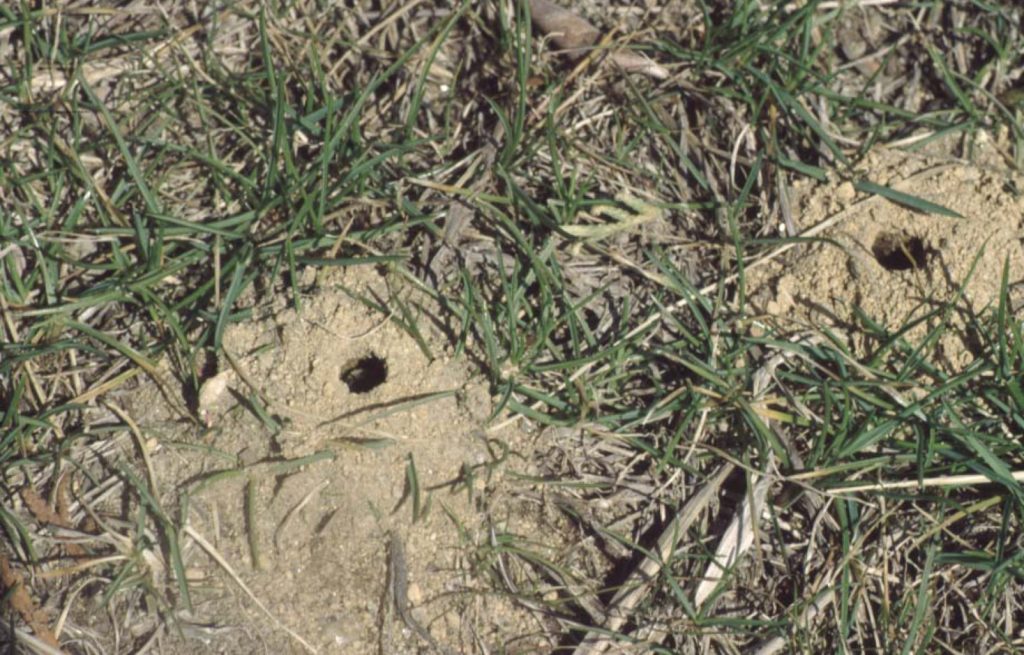National Pollinator Week Day 6: Providing Habitat for Pollinators

Communal hives of ground nesting bees. Photo: extension.unh.edu
All animals need food, water, shelter, and places to rear their young. Pollinators get their nutritional needs met from energy-rich nectar and protein-packed pollen, so offer them an abundance and diversity of native plants to keep them well-fed. Butterflies also like fruit and don’t seem to mind if it’s on the turn, so offer them a platter of cut up pieces of bananas, watermelon, or other soft fruit.
But how about hydration? Hard-working insects need water, too. They can get a drink from wet leaves or a pond, but these sources aren’t always available, and they’re are at risk of drowning (or getting eaten!) if they visit a bird bath. A pie pan or pottery dish filled with shells, stones, marbles, or beach glass will allow insects to perch while getting a drink. Be sure to clean and refill frequently, as mosquitos breed in stagnant water. You can also offer pet waterers (upside-down bottles with attached dishes) to thirsty pollinators and see who shows up.
Male butterflies visit mud puddles to extract the salts that they need both to produce pheromones that attract females and to contribute to the health of the eggs that they fertilize. You can create a mud puddling station with a bird bath or a ceramic saucer nestled into the ground. Fill with sand; add a little sea salt or compost for minerals; and keep moist with water. Use enough sand so there won’t be more than 1/8” – 1/4” of water covering the sand when it rains. Consider positioning a saucer on the ground where it will receive water draining off of the roof. It can double as a drinking hole if you add a few rocks for thirsty insects to perch on.
Non-native honeybees have it made with hives provided by their keepers, but native bees have to be more resourceful. 70% of native bee species (there are about 400 total in Massachusetts) are ground-dwellers, and they’re perfectly capable of digging and waterproofing tunnel systems to accommodate their broods. It’s a shame that people actually pay exterminators to “get rid of” ground-nesting bees, because they’re harmless and have an important role to play in the ecosystem. Instead, give them an area devoid of vegetation – a sunny south-facing slope is ideal). You can also build a frame about 2’ X 4’ and fill it to a depth of at least 4” with a 50/50 mix of sand and loam. Some ground nesters like sandy areas, while other prefer dense loam or silt-loam soil, so try experimenting with different types of soil.
The rest of our native bees are cavity nesters, and while some (such as carpenter bees) drill their own holes, most find holes in wood pre-drilled by beetle larvae or use stems for their egg chambers. Some stem nesting bees need stems that are already hollow, including those of swamp milkweed, various goldenrods, Joe Pye weed, Coreopsis, and aster, while others hollow out the pithy stalks of plants such as sumac, elderberry, and raspberry. Remarkably, female bees create several egg chambers in a single stem by provisioning each cell with mixed pollen and nectar and then sealing off the chambers with mud (mason bees), resin (resin bees), or even rolled up perfectly circular pieces of leaves that they cut out of leaf blades with their mandibles and then insert into the stalks (leafcutter bees). To ensure plenty of habitat for these bees, leave stalks standing over winter or break open some of them so that they’ll be accessible.
You’ll want to study up on the do’s and don’ts of bee hotels if you want to take it to that level. Don’t buy commercially produced bee hotels with drilled holes or bamboo stalks, as they can easily become infested with pollen mites and chalkbrood which are lethal to developing bees. Crown Bees (crownbees.com) is an excellent source of information about the proper way to offer accommodations to cavity nesting bees, collect the larvae, keep them safely refrigerated over the winter, and release them in the spring with an aboveground box that has a single hole cut out of one side.
By the way, don’t bother buying a butterfly box – no butterfly has ever been found inside of one! Evidently, they’re perfectly capable of finding shelter when it rains.
Be an eco-hero and enjoy the delights of nature by creating your own pollinator sanctuary! Please contact me if you’re interested in participating in Amherst Area Friends of Pollinators by contributing your gardening expertise, volunteering during pollinator garden workdays, donating extra native perennials for public pollinator gardens, participating in pollinator plant swaps, or helping to spread the word about welcoming pollinators.

1 thought on “National Pollinator Week Day 6: Providing Habitat for Pollinators”